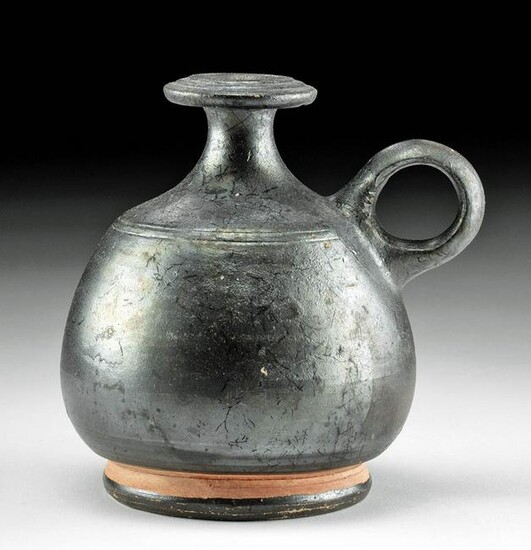Gnathian Pottery Guttus w/ Silvery Iridescence
Magna Graecia, Southern Italy, Ignazia, Gnathian, ca. 4th century BCE. An elegant pottery guttus created in a workshop in the Apulia region of southern Italy. Boasting a lustrous black glaze, this gorgeous vessel presents a squat, apple-shaped body, a gently sloped shoulder, a dramatically narrow neck, and a flared spout, all supported by a discoid foot. The flared rim is impressively adorned with 2 impressed rings, while a pair of incised, horizontal striations embellishes the shoulder. Gutti, such as this choice example, were typically used for storing oil for oil lamps. Note the stunning silvery iridescence across the black glaze! Size: 4" in diameter x 4.125" H (10.2 cm x 10.5 cm)
Gnathia ware is named for the site where it was first discovered - the Apulian site of Egnathia (also Gnatia, Egnatia, Ignazia). The black glaze ware is traditionally decorated with floral and other decorative motifs in red, white, or yellow hues. Scholars believe that its production most likely was centered around Taras, with primary workshops in Egnathia and Canosa. The quantity and quality of Greek colonial Apulian potters increased significantly following the Peloponnesian War when Attic exports dramatically decreased. Apulian artistry demonstrates influences of Ionian (Athenian, Attic) conventions, as well as Doric (western colonial Greek) styles, with a palpable native Italian aesthetic.
Provenance: private New York, New York, USA collection; ex-private T. G. collection, Williston, Florida, USA, #872, acquired in 2000
All items legal to buy/sell under U.S. Statute covering cultural patrimony Code 2600, CHAPTER 14, and are guaranteed to be as described or your money back.
A Certificate of Authenticity will accompany all winning bids.
PLEASE NOTE: Due to recent increases of shipments being seized by Australian & German customs (even for items with pre-UNESCO provenance), we will no longer ship most antiquities and ancient Chinese art to Australia & Germany. For categories of items that are acceptable to ship to Australia or Germany, please contact us directly or work with your local customs brokerage firm.
Display stands not described as included/custom in the item description are for photography purposes only and will not be included with the item upon shipping.
#166787
Condition Report: Collection label on base. Repair and restoration to rim, small area of shoulder, and handle. A few minor nicks and abrasions, commensurate with age. Otherwise, excellent with beautiful iridescence.
View it on
Sale price
Estimate
Time, Location
Auction House
Magna Graecia, Southern Italy, Ignazia, Gnathian, ca. 4th century BCE. An elegant pottery guttus created in a workshop in the Apulia region of southern Italy. Boasting a lustrous black glaze, this gorgeous vessel presents a squat, apple-shaped body, a gently sloped shoulder, a dramatically narrow neck, and a flared spout, all supported by a discoid foot. The flared rim is impressively adorned with 2 impressed rings, while a pair of incised, horizontal striations embellishes the shoulder. Gutti, such as this choice example, were typically used for storing oil for oil lamps. Note the stunning silvery iridescence across the black glaze! Size: 4" in diameter x 4.125" H (10.2 cm x 10.5 cm)
Gnathia ware is named for the site where it was first discovered - the Apulian site of Egnathia (also Gnatia, Egnatia, Ignazia). The black glaze ware is traditionally decorated with floral and other decorative motifs in red, white, or yellow hues. Scholars believe that its production most likely was centered around Taras, with primary workshops in Egnathia and Canosa. The quantity and quality of Greek colonial Apulian potters increased significantly following the Peloponnesian War when Attic exports dramatically decreased. Apulian artistry demonstrates influences of Ionian (Athenian, Attic) conventions, as well as Doric (western colonial Greek) styles, with a palpable native Italian aesthetic.
Provenance: private New York, New York, USA collection; ex-private T. G. collection, Williston, Florida, USA, #872, acquired in 2000
All items legal to buy/sell under U.S. Statute covering cultural patrimony Code 2600, CHAPTER 14, and are guaranteed to be as described or your money back.
A Certificate of Authenticity will accompany all winning bids.
PLEASE NOTE: Due to recent increases of shipments being seized by Australian & German customs (even for items with pre-UNESCO provenance), we will no longer ship most antiquities and ancient Chinese art to Australia & Germany. For categories of items that are acceptable to ship to Australia or Germany, please contact us directly or work with your local customs brokerage firm.
Display stands not described as included/custom in the item description are for photography purposes only and will not be included with the item upon shipping.
#166787
Condition Report: Collection label on base. Repair and restoration to rim, small area of shoulder, and handle. A few minor nicks and abrasions, commensurate with age. Otherwise, excellent with beautiful iridescence.



